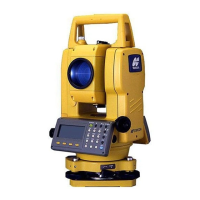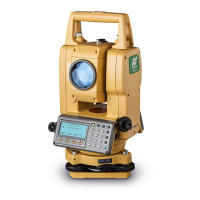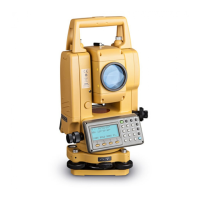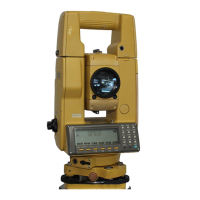Do you have a question about the Topcon GTS-230W Series and is the answer not in the manual?
Identifies and labels the physical parts of the instrument.
Explains the instrument's display screen and its various symbols.
Details the function of each key on the instrument's control panel.
Instructions on connecting the instrument to power sources.
Step-by-step guide to leveling and centering the instrument on a tripod.
Explains the automatic tilt correction feature for angle measurements.
Basic procedure for measuring horizontal and vertical angles.
Procedures for setting and measuring angles from a specific horizontal reference.
How to set atmospheric correction values for accurate distance measurement.
Instructions for setting prism constants for accurate distance measurements.
Performing continuous distance measurements to a target.
How to input the instrument's location coordinates.
Performing measurements to determine unknown point coordinates.
Accessing special measurement programs like REM and MLM.
Adjusting grid factor for map projection and coordinate calculations.
Configuring various instrument parameters like minimum reading and auto power off.
Steps required before starting data collection, like file selection.
Detailed steps for performing data collection operations.
Steps to prepare for layout operations, including file and point selection.
Procedures for performing layout tasks using stored points.
How to search for recorded measurement or coordinate data.
Operations for renaming, searching, or deleting files in memory.
Settings for sending and loading data via computer connection.
How to input temperature and pressure to set atmospheric correction.
Information on removing, charging, and refreshing the on-board battery.
Step-by-step guide to configuring the instrument's operating modes.
Detailed checks and adjustments for theodolite components like levels and crosshairs.
Steps to adjust systematic errors in the instrument's compensation system.
Explains the principle and benefit of dual axis compensation in angle measurement.
Identifies and labels the physical parts of the instrument.
Explains the instrument's display screen and its various symbols.
Details the function of each key on the instrument's control panel.
Instructions on connecting the instrument to power sources.
Step-by-step guide to leveling and centering the instrument on a tripod.
Explains the automatic tilt correction feature for angle measurements.
Basic procedure for measuring horizontal and vertical angles.
Procedures for setting and measuring angles from a specific horizontal reference.
How to set atmospheric correction values for accurate distance measurement.
Instructions for setting prism constants for accurate distance measurements.
Performing continuous distance measurements to a target.
How to input the instrument's location coordinates.
Performing measurements to determine unknown point coordinates.
Accessing special measurement programs like REM and MLM.
Adjusting grid factor for map projection and coordinate calculations.
Configuring various instrument parameters like minimum reading and auto power off.
Steps required before starting data collection, like file selection.
Detailed steps for performing data collection operations.
Steps to prepare for layout operations, including file and point selection.
Procedures for performing layout tasks using stored points.
How to search for recorded measurement or coordinate data.
Operations for renaming, searching, or deleting files in memory.
Settings for sending and loading data via computer connection.
How to input temperature and pressure to set atmospheric correction.
Information on removing, charging, and refreshing the on-board battery.
Step-by-step guide to configuring the instrument's operating modes.
Detailed checks and adjustments for theodolite components like levels and crosshairs.
Steps to adjust systematic errors in the instrument's compensation system.
Explains the principle and benefit of dual axis compensation in angle measurement.
| Brand | Topcon |
|---|---|
| Model | GTS-230W Series |
| Category | Measuring Instruments |
| Language | English |











